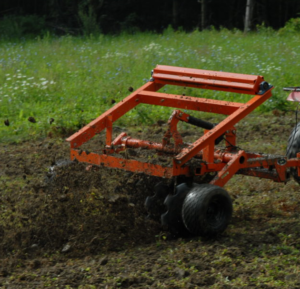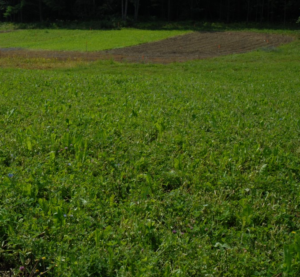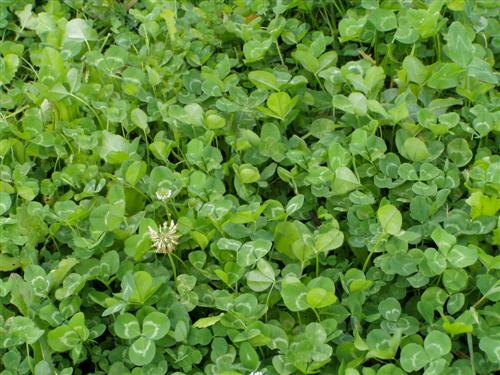Food Plot Forages: What Should I Plant?
The main decision when choosing food plot forage is whether you want to attract deer for hunting or provide year-round nutrition for deer and other wildlife.
Food Plot Forage for Whitetail
Forage is something grown for an animal to eat. In the hunting game, it is typically a food plot grown to feed and attract deer. Twenty years ago, purchasing food plot seed was simple; there was clover and there was, well, clover. Not so today; there are literally hundreds of food plot forages out to choose from. You can make it as easy or difficult as you want–we choose easy. The central question when selecting a food plot forage is “What do I want my food plots (forage) to contribute to the overall property management program? Do I want something green to hunt over or do I want something to nourish deer and wildlife all year long?” Once this question is answered, the rest is easy.
A lot of this work starts in April & May, as we discussed in Whitetail Playbook: Building Successful Deer Plots and the May Deer Hunter’s Almanac.
Annuals and Perennials (Mix and Match)
If you’re just about attracting deer for fall hunting, more than likely you will be planting an annual forage in the late summer or early fall. Annual plants grow for a few months, mature, and then die. On the other hand, if you want to attract and provide nourishment for your deer all year around, you are talking about growing both annuals and perennials.
When considering foot plot forage for whitetail deer, we generally recommend planting at least 60% of a property in perennial forages, which leaves the other 40% for annuals. If you are just starting out, you may choose to run late-season annuals for a year or two, but if you are serious about developing a property that holds and nurtures high-quality deer, your property should offer high-quality nutrition 24-7-365, and that means planting both annuals and perennials.
Both annuals and perennials provide great nutrition with protein levels in the 25-35% range (depending on the season). The average white-tailed deer consumes 6-8 pounds of food per day and feeds approximately 6 times per day. An acre of food plot forage can provide 4 tons of high-quality forage per year. Good deer forages are highly digestible and a real boon to wildlife.
Perennial Blends
We like perennials because they green up early in spring and produce well into the late fall and early winter. That way lactating does and bucks growing antlers will always have something nutritious to feed on. Perennial food plot mixes are generally clover-based plots, which are just fine with whitetails. Clover is the staple of the food plot industry and shows no signs of weakening. It is relatively easy to grow, easy for deer to digest, and very nutritious at 25% protein. Clover likes moist conditions and can tolerate “wet feet” to some extent. However, it does not like hot dry temperatures and generally goes dormant at about 85 degrees. Chicory, on the other hand, has a deep taproot and likes it hot and dry. Blending chicory with clover is a very sound approach to perennial food plots. Evolved Clover Pro does a very nice job with their clover blends.

Annuals
The main objective of planting fall annuals is to attract whitetails to hunting locations. Sure, late summer and early fall plantings feed deer, and some food is better than no food at all, but (especially in poor habitat areas) unless the seeding carries over into winter (like a few acres of brassicas or high sugar oats often will), the deer are getting a free lunch just when they need it least.
All kinds of annuals are available for food plotters to choose from, grain-based annuals like winter wheat, rye, and high-sugar oats are easy to grow and will generally stay green well into the winter. Whitetails love the tender young sprouts they put out and stay on them until they reach 8-12 inches in height. After that, they generally seek other forages (provided there are any around).
Brassicas is a favorite of northern food plotters. Its wide leafy plants are rich in protein (35%) and are highly attractive to deer after a hard frost or cold spell. Deer come to them like magnets during the late hunting seasons and unless totally consumed will be used well into winter. They hold up well to snow and provide excellent early winter food.
Seed manufacturers do a big business blending annual mixes for specific purposes. They bag blends for poor soils and hot dry locations, for folks without any cultivating equipment, and just about any need a would-be food plotter would have. Specialty seed mixes vary by manufacturer but it’s hard to find a need that hasn’t been addressed by someone.
Balance Your Blends
We prefer a mixture of high-protein forages that stay available all year, from early spring through winter. We want to meet the nutritional needs of lactating does, nursing fawns and bucks growing antlers, so clovers, chicories, brassicas, and some alfalfas are hard to beat. We only plant brand-name forages designed for deer. These blends grow low and dense, and are low in stem material (except brassicas stalks) or lignin. Their density keeps down competing weeds. They’re designed to be grazed, and as such, mature at different times of the year. These forages have been thoroughly researched and engineered to perform as advertised. They save you huge amounts of money and time, and your deer will thrive on them.

Avoid Cattle Forages
A note of caution: we recommend staying away from cattle forages like some red clovers, tall white ladino clover, and timothy grass. Cattle forages like these are grown to be chopped or baled and fed dry to cows and horses. They are high in coarse stem materials and lignins, which deer do not digest as well as cattle do. They don’t stand up well to constant grazing as deer are apt to do. Cattle forages are often blended and sold at local feed and seed stores at prices 10-15% under what brand-name seeds sell for. Buyer beware, they will no doubt grow but you will do much better with blends designed expressly for whitetails. Developing and blending deer forages is nothing simple or easy, but staying away from cattle forages is an easy way to avoid disappointment.
In Summary – our advice on each topic:
- Annuals and Perennials:
- If you’re primarily interested in attracting deer for fall hunting, you’ll likely plant an annual forage in late summer or early fall.
- For year-round attraction and nourishment, you should plant a mix of annuals and perennials.
- It’s generally recommended to plant at least 60% of your property in perennial forages, and the remaining 40% in annuals.
- Perennial Blends:
- These green up early in spring and produce well into late fall and early winter.
- Clover is the staple of the food plot industry. It’s easy to grow, digest, and highly nutritious.
- Chicory is a good complement to clover, as it thrives in hot, dry conditions.
- Annuals:
- The main goal of planting fall annuals is to attract whitetails to hunting locations.
- Grain-based annuals like winter wheat, rye, and high-sugar oats are popular choices.
- Balance Your Blends:
- The best food plot strategy involves a mix of high-protein forages available all year.
- Clovers, chicories, brassicas, and some alfalfas are recommended.
- Avoid Cattle Forages:
- Stay away from cattle forages like some red clovers, tall white ladino clover, and timothy grass.
- These types of forages are often coarse and don’t stand up well to constant grazing.
Remember, there’s nothing simple or easy about developing and blending deer forages, but the right choices can lead to healthier deer and more successful hunting.









![The Best Deer Camp Chili [VIDEO] Deer Chili Ingredients, Tomatoes, Chili Spices](/wp-content/uploads/2015/10/Deer-Chili-Deer-Camp-Recipe-218x150.jpg)








![How to Call Elk Early in the Season [VIDEO]](/wp-content/uploads/2016/08/byers003-218x150.jpg)




![Idiots Disturb Hunter: How Would You Have Handled It? [VIDEO]](/wp-content/uploads/2015/10/DSC00110-e1474487693878-100x70.jpg)
![Albino Buck Shocked to Shed His Antlers [VIDEO]](/wp-content/uploads/2015/10/AlbinoDeer-100x70.jpg)